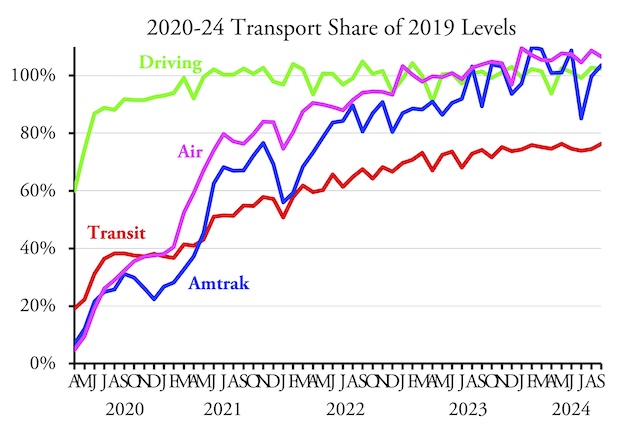Amtrak carried 4.8 percent more riders and 3.5 percent more passenger-miles in September 2024 than in the same month of 2019, according to the September monthly performance report that it posted yesterday. For Amtrak’s fiscal year, which ended September 30, it carried 0.8 percent more riders and 0.9 percent more passenger-miles than in F.Y. 2019.
Amtrak earned $2.5 billion in ticket revenues and food & beverage sales in F.Y. 2024. That works out to about 38.4¢ per passenger-mile. For comparison, commercial airline fares averaged 20.1¢ per passenger-mile in 2023.
Amtrak also collected $314 million from the states to subsidize passenger trains. It calls these state subsidies “passenger related revenues,” but they are really just subsidies in the same way that dollars provided by the federal government are subsidies.
Amtrak says that its 2024 operating costs were $4.3 billion or an average of 66.1¢ per passenger-mile. However, this does not count depreciation, which it says was $966 million or 14.8¢ per passenger-mile. Some of its operating costs were covered by state subsidies; some by federal subsidies. The depreciation wasn’t covered at all, which is why Amtrak’s infrastructure is in such poor shape.
The reason why railroads and other companies measure depreciation is so they can show investors that they are earning enough revenue to replace their infrastructure when it wears out. Amtrak can’t so it pretends depreciation doesn’t count and then demands government bailouts when its infrastructure is falling apart.
Amtrak also says that it earned $795 million in what it calls “ancillary revenue” and “other core revenue.” This includes things like payments from freight railroads for using Amtrak’s tracks in the Northeast Corridor. Amtrak could earn these revenues if it didn’t operate any passenger trains, but at least the reduced the subsidies required to run the passenger trains.
Amtrak’s bottom line is that it claims to have lost $1.8 billion in 2024. However, this counts the state subsidies as revenues; discounting them increases the losses to $2.1 billion or 32.4¢ per passenger-mile. This is Amtrak’s operating subsidy for 2024. For comparison, subsidies to the airlines averaged about 3 cents a passenger-mile in 2023 and were probably less in 2024.
Amtrak also spent $4.5 billion on capital costs, up from $2.9 billion in 2023. Much of this went to repair or replace worn-out infrastructure in the Northeast Corridor. The 2021 infrastructure bill included about $20 billion for such infrastructure repair, but that is only about half of what Amtrak says it needs to put the Northeast Corridor in a state of good repair.
The average American rode Amtrak about 19 miles in 2024. This compares with about 15,000 miles by automobile and around 2,000 miles by plane. Needless to say, I don’t believe the billions of dollars in subsidies going to Amtrak are justified by this tiny amount of travel provided by the state-owned company.









Hopefully Trump will shut down Amtrak once and for all. With cars never being so affordable, there’s no more need for public transit.
https://x.com/unusual_whales/status/1859964300737290277
Jane, your sarcasm falls flat. What you say is actually true. Cars have always been more affordable than Amtrak, which is one of the many reasons why cars have always been more popular than Amtrak. Realistically, Trump won’t be able to completely shut Amtrak down but, hopefully, he will clip its wings. It’s time!